Trading capital is a critical fact when you want to participate in the forex market. The capital size relates to many different realities, such as trading strategies, trade duration, leverage, risk management, etc.
You may be thinking that you can start trading with a $100 capital in the forex market or not. However, making a constant profit in the FX market with a $100 capital involves particular skills, strategies, and mindset besides following essential trade and money management rules.
This article contains the guideline to trading forex with a $100 capital besides listing proper trading strategies with chart attachments and the top advantages and limitations.
What is a $100 trading?
Many people may think that $100 is nothing in the forex market with the most liquidity and trillions of dollar transactions. That’s not true, as traders with specific skills can make a lot of money from a $100 investment. There is a massive difference between “can do” can “should do.” For example, the legendary Chinese forex trader Chen Linkuy, who made approx. $100,000 within a few weeks from not more than a $100 trading capital.
Anyway, Linkuy got skills and didn’t follow any money or trade management rules in trading. We mention Linkuy to give an idea about potentiality. Many brokers will allow you to have leverage from 1:1-1:1000, which means you can make trades worth $1000 with your $1 capital.
However, that will be a risky practice. For successful trading, every trader should follow proper rules of trade and money management. Ignoring these facts causes losing the first deposit of every novice forex trader.
How to trade with a $100 capital
When you decide to trade forex with $100, you have to follow some proper guidelines. Otherwise, you can end up losing your capital as most newcomers do. Follow the suggestions below.
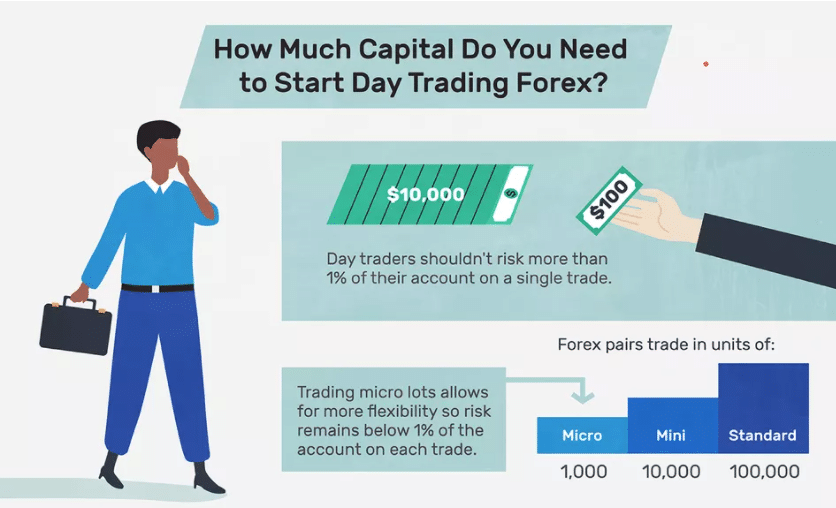
Account type
With a $100 capital, it won’t be wise to choose a standard account to trade forex. Many brokers offer a micro account feature that is suitable for this little capital.
Leverage
It is one of the critical factors for financial traders. Brokers often offer different leverages for different financial assets such as securities, stocks, forex, CFD, commodities, etc. Don’t misuse this feature; try to use less leverage. You can increase your leverage gradually, depending on your skills and trade results.
Avoid overtrading and emotional trading
It will be a costly practice to perform overtrading. Most traders lose money due to over-trading and emotional trading. When you can’t determine the future movement, avoid trading. In this way, your capital will be safe.
Technical and fundamental
Observe the market technically and fundamentally before making any entry positions. Avoid making trades during major fundamental events.
Risk and trade management
These are essential factors. Never risk more than 2% of your trading capital for trading, place tight stop loss and take profits for traders. Don’t be greedy, as a 1% profit is vast for large investors while a 15-20% monthly profit is quite a reasonable sum for forex traders.
Winner mindset
It is vital to develop a winning mindset. After making some winning trades, traders often get excited and start to make wrong decisions due to overconfidence that costs them money. Sometimes, traders lose confidence due to some bad choices and make wrong decisions due to fear. Avoid these factors to make constant profits.
A short-term strategy
Our short-term strategy is an EMA crossover strategy. We use three different EMA, which are EMA 21 (green), EMA 50 (blue), and EMA 200 (yellow). We recommend using a 15-min chart to seek short-term trade setups, although this strategy applies to any time frame charts above it.
Bullish trade scenario
Apply the EMA lines at your target asset chart and check:
- The green EMA line crosses the blue EMA line on the upside.
- Both the green and blue EMA lines cross the yellow EMA line on the upside.
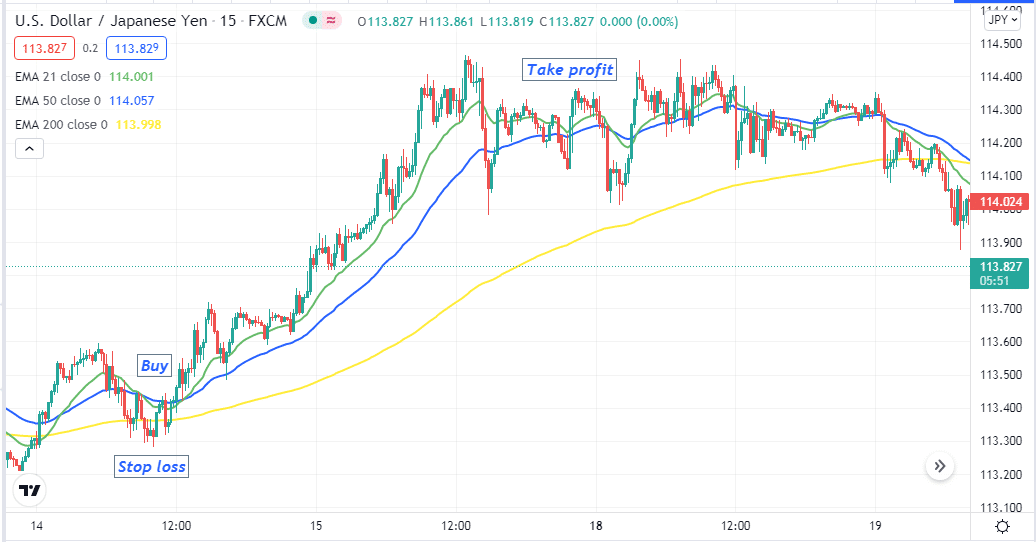
When these conditions above match with your chart, place a buy order. The initial stop loss will be below the current swing low with a 5-10 pips buffer. Close the buy position when the green EMA line crosses the blue EMA on the downside.
Bearish trade scenario
Apply the EMA lines at your target asset chart and check:
- The green EMA line crosses the blue EMA line on the downside.
- Both the green and blue EMA lines cross the yellow EMA line on the downside.
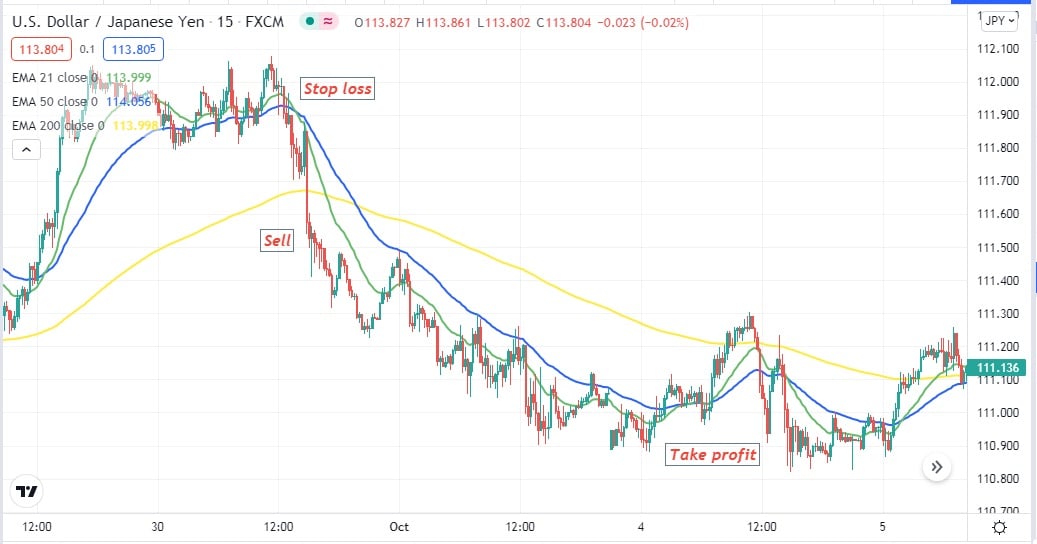
When these conditions above match with your chart, place a sell order. The initial stop loss will be above the current swing high with a 5-10 pips buffer. Close the sell position when the green EMA line crosses the blue EMA on the upside.
A long-term strategy
Our long-term strategy involves using two popular technical indicators, the MACD and the Stochastic. This trading method applies to any time frame chart; we recommend using an H4 chart or above to get excellent results.
Bullish trade scenario
When the price reaches any low and starts to bounce back toward the upside check:
- The dynamic blue lines cross the dynamic red lines upside down on both indicator windows.
- Both dynamic lines are above or near the upper line of the stochastic window.
- MACD green histogram bars appear above the central line.
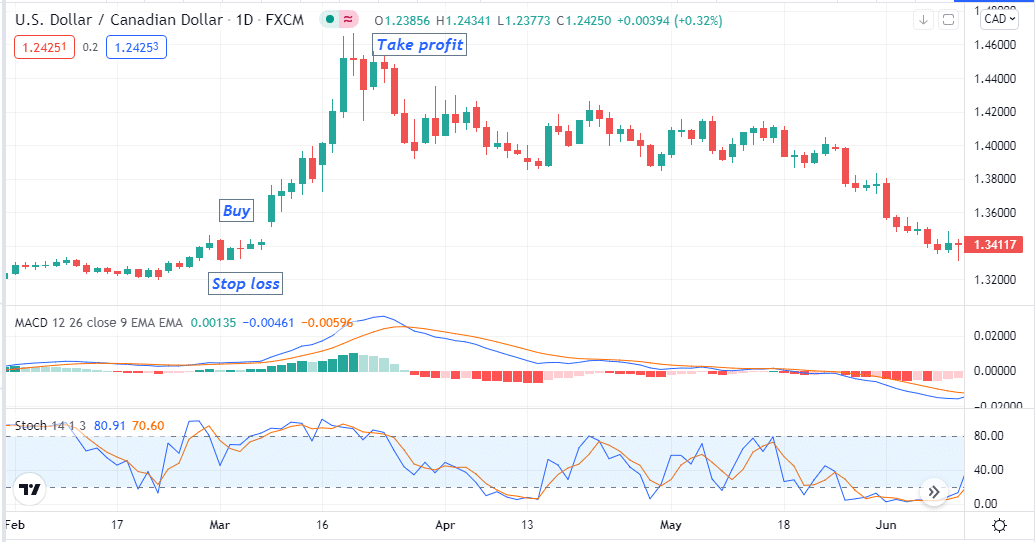
If all these conditions above match your target asset chart, place a buy order with a stop loss below the current low. Close the buy order when:
- MACD red histogram bars start to take place below the central line.
- Dynamic blue lines cross below dynamic red lines on both indicator widows.
Bearish trade scenario
When the price reaches any high and starts to bounce back toward the downside check:
- The dynamic blue lines cross the dynamic red lines downside on both indicator windows.
- Both dynamic lines are below or near the bottom line of the stochastic window.
- MACD red histogram bars appear below the central line.
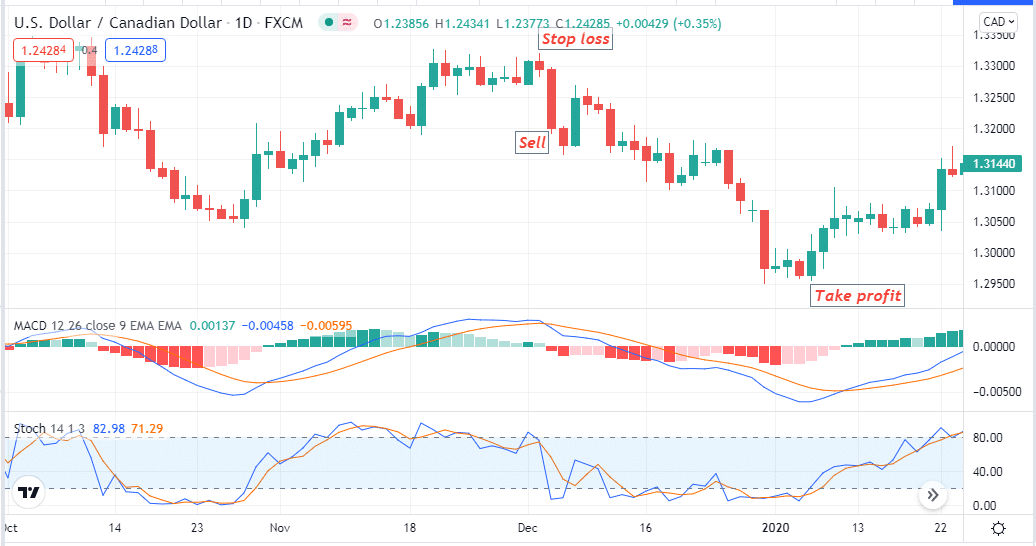
If all these conditions above match your target asset chart, place a sell order with a stop loss above the current high. Close the sell order when:
- MACD green histogram bars start to take place above the central line.
- Dynamic blue lines cross above dynamic red lines on both indicator widows.
Pros and cons
| Pros | Cons |
| You will lose small capital. | Tiny capital will give you a small return. |
| It is a better capital size for learners. | Making frequent trades can be an addiction. |
| You can participate in both short-term and long-term trading. | Risk of overtrading to make more profits. |
Final thought
Finally, a $100 capital is quite enough to start trading, but it won’t allow you to trade using a standard account or making more profits. We suggest increasing capital size with your trading experience, skills, and trading results. You can’t be a millionaire overnight; follow the procedures of smart traders to be a successful forex trader.
